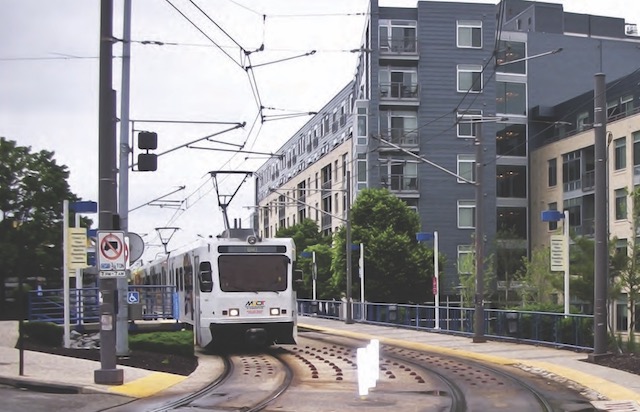Maryland has decided it needs to “take a more active role in promoting development around transit stations,” according to an article in the Baltimore Banner. “It’s priming the pump to get these things moving,” says Secretary of Transportation Paul Wiedefeld, who used to be general manager of Washington Metro.
Maryland’s stack-’em-and-pack-’em vision for transit recovery. But what if nobody wants to live there?
As of May, Baltimore transit ridership was about 67 percent of pre-pandemic levels, slightly less than the national average. But most of that was due to buses, which were at 73 percent. Baltimore light rail was only 59 percent and Baltimore’s subway was just 58 percent. Wiedefeld hopes that promoting transit-oriented developments will boost ridership.
Some people believe that transit-oriented developments successfully attracted riders to the DC Metro rail system. But Baltimore isn’t DC, and light rail isn’t the same as DC’s subway. Even Baltimore’s subway is a pathetic imitation of a real subway system.
In 2019, Baltimore’s subway carried about 1,550 weekday riders per route mile, compared with 6,800 on the DC subway and 14,000 on Boston’s. Baltimore’s light rail was less than 770, barely more than 10 percent of Boston’s light rail. Baltimore rail transit is such a failure that, even if transit-oriented development truly increased ridership and one were built at every rail station in Maryland, it wouldn’t make rail transit in Baltimore viable.
Maryland needs to learn from the experiences with transit-oriented developments elsewhere. First, they are expensive to build, typically costing more than $300 per square foot or more than twice the cost of a single-family home. Second, most people don’t want to live in one. Even with high housing prices in West Coast cities, many if not most of the transit-oriented developments are being heavily subsidized as “affordable housing” for people who have little choice about where to live.
Finally, there really isn’t much evidence that transit-oriented developments actually boost transit ridership. True, the people who moved into the early ones self-selected for those who wanted to ride transit. But that doesn’t mean that getting other people who normally drive a lot to live in them will suddenly change their transportation needs or habits. Economist David Brownstone concluded that, once self-selection is accounted for, the effects of the type of development on transportation are “too small to be useful.”
Of course, Maryland won’t learn about these experiences because transit agencies doing transit-oriented developments in other parts of the country have all drunk the Kool-Aid. They use a simple technique to disguise the fact that transit-oriented developments don’t increase transit ridership: they never evaluate the results of their projects, they just fund more. As the Cascade Policy Institute’s John Charles has found, transit-oriented development is a “myth.” As a result, Maryland taxpayers are going to be taken for a ride, and it won’t be on light rail.









Nashville’s growing like a weed. Yet there’s barely a TOD been built along the Music City Star. Almost like it repels growth instead of attracting it.
Population decline in cities & towns is a good thing. When a place fails, ppl should be able to leave. But urbanism’s goal is to cram people into inescapable, large dense cities under monolithic political control.